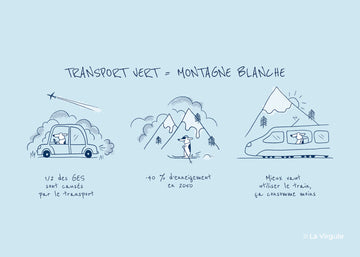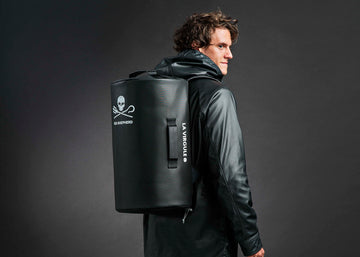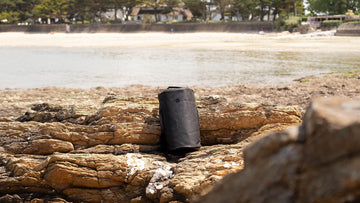Increasingly rare snow
This is the question that we do not necessarily ask ourselves when putting on our skis but which nevertheless becomes more and more worrying... The resource center for adaptation to climate change affirms that our mountains are the areas of our beautiful planet which heat up the fastest. With an increase of 2°C in the French Alps and Pyrenees during the 20th century (compared to 1.4°C in the rest of France), snow becomes rarer below 2000m. “Around 2050, the snow cover will have lost 10 to 40% of its thickness, in mid-mountains, regardless of the concentration of greenhouse gases in the atmosphere.” Even if artificial snow can help us for a while, from a certain threshold, it will no longer be sufficient to replace natural snow.
The carbon footprint of a day of skiing
Our participation in global warming therefore directly impacts our favorite sport. At the same time, our favorite sport has a fairly significant carbon footprint on our planet. A circle that never ends. Ski resorts, symbols of winter holidays and magical landscapes, therefore raise growing concerns about their impact on the environment. A study carried out by the Utopies firm in 2022 calculates the carbon footprint for a day of skiing.Which of the snow cannons, the beer taps at Folie Douce or the computer system of the ski lifts weighs more heavily in the balance? None of the three! The transport of skiers constitutes the first source of greenhouse gas (GHG) emissions, 52%. The carbon footprint of traveling by car or plane to get to ski resorts therefore represents a major burden, thus accentuating global warming and its consequences on mountainous regions.

The study also highlights the impact of the development of ski resorts on our planet (17% of GHG emissions). The construction of infrastructure as well as equipment and services linked to tourist activities are leading to a profound transformation of the mountainous landscape.

Other aspects such as electricity consumption or waste management contribute to increasing GHGs and therefore the carbon footprint of mountain stays. The use of snow cannons to compensate for the lack of natural snow, as well as the operation of ski lifts and buildings, generate considerable electricity consumption. As for waste, the influx of tourists during the winter season leads to increased production of waste, some of which is not properly managed or recycled, threatening fragile alpine ecosystems. Part of the excess waste is even sent to our Swiss neighbors to be incinerated at home. We ski on our heads…
Solutions ?

Faced with these challenges, initiatives are still being put in place to mitigate the environmental impact of ski resorts. Transportation represents a major part of the carbon footprint of a day of skiing. An incentive to use more sustainable modes of transport such as train, bus or even carpooling can therefore be put in place. By no longer taking the plane and minimizing the use of the car to get to the slopes, this percentage (52%) could decrease drastically!
How to get to the slopes using a more sustainable mode of transport?
Mollow is a site that allows you to find your low-carbon route to your favorite ski resort. You can find Les Arcs, the station is accessible by funicular after a trip by train or bus, Les Trois Vallées, by bus from Bourg Saint Maurice or even Serre Chevalier by night train from Briançon.

The goal is obviously to continue to enjoy these beautiful mountainous landscapes while respecting them. To continue to achieve your most beautiful descents while keeping in mind that you will be able to do it for a long time.
At La Virgule, it is by creating upcycled bags from end-of-life sports equipment that we help preserve these beautiful white valleys. Enough to still enjoy these landscapes without leaving any other imprint than that of your skis.














